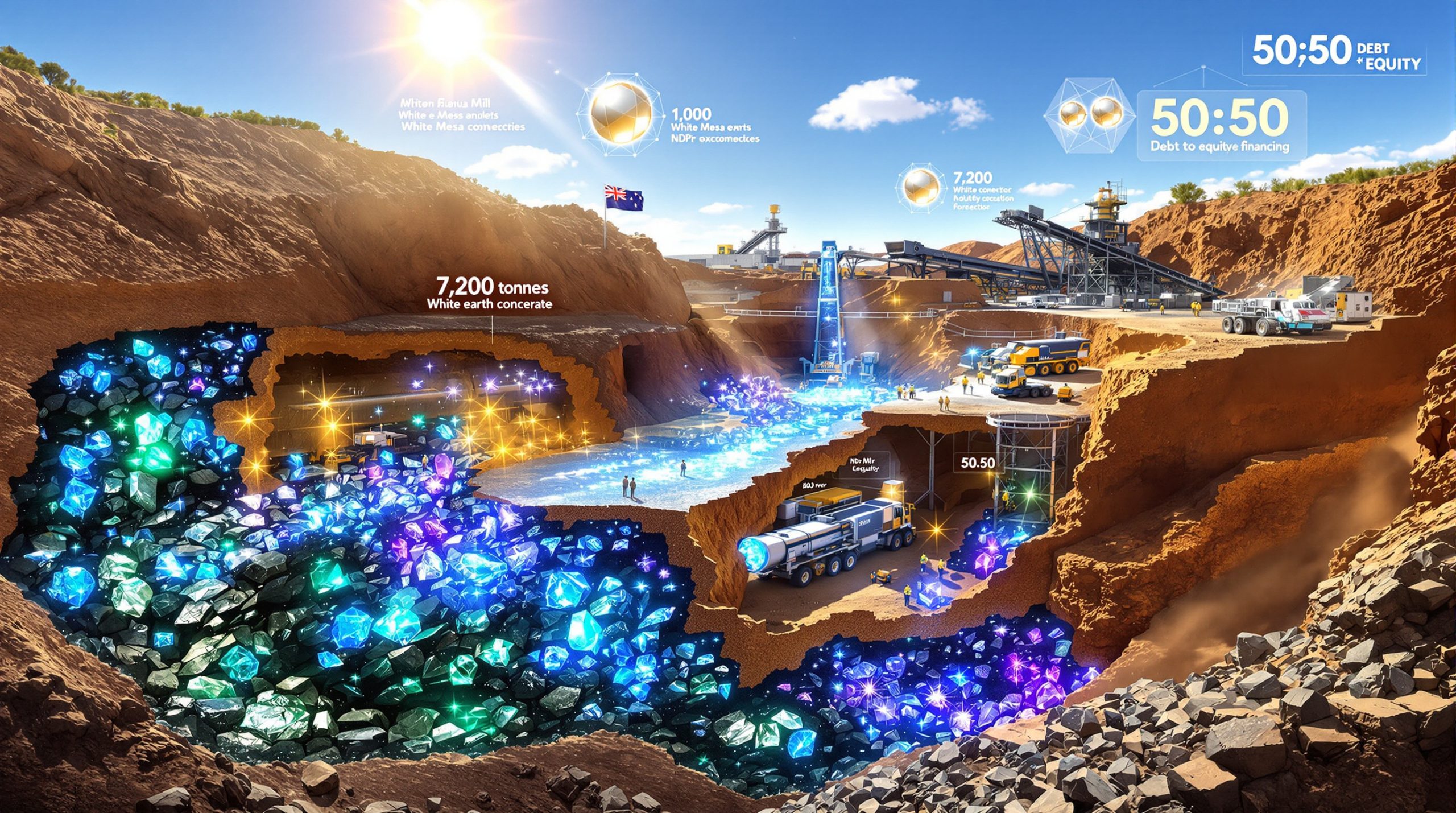What Makes Rare Earth Elements Critical to U.S. National Security?
America's dependence on foreign rare earth element supplies has reached a critical juncture, with national security implications extending far beyond economic considerations. The USA Rare Earth supply chain has become a cornerstone of modern defense systems, clean energy infrastructure, and advanced manufacturing capabilities. These seventeen unique elements, ranging from cerium to lutetium, form the backbone of technological superiority.
The strategic vulnerability becomes apparent when examining current import statistics. The United States relies on foreign suppliers for approximately 80% of its rare earth element needs, creating a supply chain bottleneck that affects everything from missile guidance systems to wind turbine manufacturing. Consequently, this dependency translates to billions of dollars in annual imports while simultaneously constraining domestic technological advancement.
Strategic Importance of Heavy vs. Light Rare Earth Elements
Understanding the distinction between heavy and light rare earth elements reveals why domestic production has become a national priority. Light rare earth elements, including neodymium and praseodymium, are essential for permanent magnet production in electric vehicles and wind turbines. Furthermore, heavy rare earth elements like dysprosium and terbium provide critical performance enhancements for high-temperature military applications and advanced electronics.
Military applications demand the highest purity grades, often requiring 99.9% or greater purity levels for optimal performance. Current foreign suppliers control these specialized processing capabilities, creating strategic vulnerabilities in defense manufacturing. In addition, the Pentagon's requirements for submarine sonar systems, radar installations, and precision-guided munitions all depend on consistent access to these materials.
Economic Impact of Supply Chain Dependencies
The financial implications of rare earth import dependence extend beyond immediate procurement costs. Market volatility driven by geopolitical tensions can cause price fluctuations exceeding 300% within single quarters, disrupting manufacturing schedules and increasing end-product costs for American consumers.
Domestic rare earth production promises significant economic benefits through job creation across multiple sectors:
- Mining operations: 2,000-3,000 direct jobs per major facility
- Processing plants: 1,500-2,500 specialized technical positions
- Manufacturing hubs: 5,000-8,000 advanced manufacturing roles
- Supporting industries: 15,000-20,000 indirect employment opportunities
Where Are America's Key Rare Earth Mining Operations Located?
Strategic geographic distribution of rare earth resources across the United States provides multiple pathways for supply chain resilience. Current development focuses on three primary regions, each offering distinct advantages for different elements and applications. However, these developments require sophisticated approaches to the modern mine planning process to maximise efficiency and environmental compliance.
Texas Mining Developments
The Round Top deposit in West Texas represents one of America's most promising rare earth resources, containing fifteen of the seventeen rare earth elements alongside valuable byproducts including lithium, gallium, and hafnium. This geological formation spans approximately 1,200 acres with estimated resources exceeding 16.7 billion pounds of total rare earth oxides.
Production timelines indicate first commercial output by late 2026, with full capacity operations projected for 2028. The facility's design incorporates advanced processing technologies that minimise environmental impact while maximising extraction efficiency. Moreover, permitting progress has accelerated under streamlined federal review processes, with key approvals expected throughout 2025.
Environmental considerations include comprehensive water management systems and waste minimisation protocols. The operation utilises closed-loop processing to prevent groundwater contamination while maintaining production efficiency standards required for defense applications.
California's Established Mining Infrastructure
Mountain Pass facility in California stands as America's primary operational rare earth mine, currently producing approximately 38,000 metric tons annually of rare earth concentrate. This established infrastructure provides immediate capacity for light rare earth element production, particularly neodymium and praseodymium essential for magnet manufacturing.
Recent partnerships with the Department of Defense have expanded processing capabilities to include higher-purity materials suitable for military applications. Investment commitments totalling $200 million over three years will enhance separation and refinement technologies while maintaining environmental compliance standards.
The facility's strategic advantage lies in its proximity to West Coast manufacturing centres and established transportation infrastructure. Rail connections provide direct access to processing facilities while minimising logistics costs and delivery timeframes for critical applications.
Wyoming's Emerging Resource Potential
The Wheatland area in southeastern Wyoming contains substantial rare earth deposits with estimated resources approaching 2.3 billion tons of mineralised material. Initial assessments indicate concentrations suitable for commercial extraction, particularly for heavy rare earth elements currently unavailable from domestic sources.
Development timelines extend into the early 2030s, requiring substantial infrastructure investment and advanced processing technology implementation. The scale of this resource could potentially supply 20-25% of total U.S. rare earth demand once fully operational.
Regional economic impact projections include:
| Economic Indicator | Projected Impact |
|---|---|
| Direct employment | 4,500-6,000 jobs |
| Annual payroll | $450-600 million |
| Local tax revenue | $75-100 million annually |
| Infrastructure investment | $2.8-3.5 billion |
How Are Companies Creating Integrated Processing Facilities?
Vertical integration strategies across the rare earth supply chain represent a fundamental shift toward domestic self-sufficiency. Companies are establishing comprehensive mine-to-magnet operations that eliminate foreign processing dependencies while maintaining quality control throughout production cycles. These developments align with broader mining industry evolution trends emphasising technological integration and operational efficiency.
Oklahoma Manufacturing Hub Development
The Stillwater facility in Oklahoma represents America's largest planned rare earth processing and manufacturing complex, designed to produce 5,000 metric tons of permanent magnets annually by the first half of 2026. This integrated approach combines separation, refinement, alloying, and magnet production within a single operational framework.
Technology transfer agreements with international partners provide access to advanced processing methods while maintaining domestic operational control. The facility incorporates automation systems that reduce labour costs while improving consistency and quality metrics essential for defense applications.
Workforce development initiatives include partnerships with regional universities and community colleges to establish specialised training programmes. These educational frameworks ensure adequate skilled labour availability while creating career pathways for advanced manufacturing roles.
Vertical Integration Strategies
Modern rare earth operations require sophisticated integration across multiple processing stages:
Mining and Concentration
- Ore extraction and initial processing
- Concentration to 60-70% rare earth oxide content
- Quality control and contamination prevention
Separation and Refinement
- Individual element separation using solvent extraction
- Purification to 99.9%+ purity levels
- Specialised processing for heavy rare earth elements
Metal Production and Alloying
- Conversion from oxides to metallic form
- Alloy development for specific applications
- Strip casting and powder metallurgy processes
Magnet Manufacturing
- Sintered magnet production for permanent applications
- Bonded magnet development for specialised uses
- Quality assurance and performance testing
What Government Initiatives Support Domestic Rare Earth Development?
Federal support mechanisms span multiple agencies and funding streams, reflecting the strategic importance of domestic rare earth capabilities. These initiatives combine financial incentives with regulatory streamlining to accelerate development timelines while maintaining environmental standards. Furthermore, these efforts complement broader critical minerals energy transition strategies essential for national security.
Department of Defense Funding Programs
Defense Production Act utilisation provides $750 million in initial funding for critical mineral projects, with additional appropriations under consideration for fiscal years 2025-2027. These investments prioritise projects demonstrating clear pathways to defense-grade material production within specified timeframes.
Military contractor requirements increasingly specify domestic sourcing preferences for rare earth components. New procurement regulations establish domestic content thresholds of 75% or higher for critical defense systems, creating guaranteed market demand for American producers.
Strategic stockpiling initiatives maintain 90-day supply reserves for essential rare earth materials while providing price stability mechanisms for domestic producers. These buffer stocks help mitigate market volatility while ensuring continuous supply availability during geopolitical disruptions.
Department of Energy Investment Framework
Clean energy technology support mechanisms allocate $2.1 billion over five years for rare earth projects supporting wind energy, electric vehicle manufacturing, and grid modernisation initiatives. These investments target projects demonstrating clear environmental benefits alongside supply chain security improvements.
Research and development grants focus on innovative processing technologies that reduce environmental impact while improving extraction efficiency. Current priorities include:
- Advanced separation techniques reducing chemical usage by 40-60%
- Recycling technologies for end-of-life rare earth products
- Alternative processing methods minimising water consumption
- Automation systems improving worker safety and productivity
Which Industries Drive Demand for American Rare Earth Materials?
Domestic demand patterns reveal the interconnected nature of rare earth applications across critical infrastructure sectors. Understanding these consumption patterns helps prioritise production capabilities while identifying growth opportunities for domestic suppliers. However, successful implementation requires comprehensive raw materials facility insights to optimise processing operations.
Defense and Aerospace Applications
Military applications consume approximately 15-20% of total U.S. rare earth demand, but represent the highest value and most critical applications. Defense systems require exceptional reliability and performance standards that justify premium pricing for domestically produced materials.
Specific defense applications include:
Guidance and Navigation Systems
- Precision-guided munitions requiring terbium-enhanced components
- Satellite communication systems utilising erbium-doped amplifiers
- Radar installations incorporating neodymium-based permanent magnets
Propulsion and Power Systems
- Aircraft engine components requiring heat-resistant rare earth alloys
- Submarine propulsion systems utilising high-performance magnets
- Space exploration vehicles incorporating lightweight rare earth materials
Clean Energy Sector Consumption
Renewable energy infrastructure represents the fastest-growing segment of rare earth demand, with wind energy alone requiring 600-800 pounds of rare earth materials per megawatt of installed capacity. Current expansion plans indicate demand growth of 12-15% annually through 2030.
Electric vehicle manufacturing consumes approximately 2-10 pounds of rare earth materials per vehicle, depending on drivetrain configuration and performance requirements. Domestic EV production targets of 15 million vehicles annually by 2030 would require substantial increases in rare earth supply capacity.
Energy storage systems increasingly incorporate rare earth components for improved performance and longevity. Battery technologies utilising rare earth materials demonstrate 20-30% longer service life compared to conventional alternatives, justifying higher material costs through lifecycle value.
Consumer Electronics and Robotics
Consumer electronics applications consume the largest volume of rare earth materials, though typically at lower purity requirements than defense or aerospace uses. Smartphone manufacturing alone accounts for millions of pounds annually of combined rare earth consumption across displays, speakers, and motors.
Industrial automation and robotics represent emerging high-growth applications requiring specialised rare earth components:
- Precision motors for robotic assembly systems
- Sensor technologies for autonomous manufacturing
- Advanced ceramics for high-temperature industrial processes
- Specialised alloys for medical device manufacturing
What Challenges Face America's Rare Earth Supply Chain Development?
Technical and economic obstacles continue to impede rapid development of domestic rare earth capabilities. Understanding these challenges provides insight into realistic development timelines and investment requirements for successful projects.
Technical Processing Complexities
Rare earth separation and purification requires sophisticated chemical processing capabilities that few domestic facilities currently possess. The complexity stems from the similar chemical properties of rare earth elements, necessitating multi-stage separation processes with 95%+ efficiency requirements to achieve commercial viability.
Environmental management presents significant technical challenges:
Modern rare earth processing must balance extraction efficiency with environmental stewardship, requiring innovative approaches to waste management and water treatment that maintain competitive economics while meeting regulatory standards.
Skilled workforce development represents a critical bottleneck, with limited educational programmes available for specialised rare earth processing techniques. Current estimates indicate 3,000-5,000 additional skilled technicians will be required to support planned domestic capacity expansion through 2030.
Market Competition and Pricing Pressures
International pricing dynamics create substantial challenges for domestic producers attempting to establish market presence. US efforts to secure rare earth supply chains face competition from established foreign suppliers who benefit from decades of operational experience and economies of scale that enable 20-40% lower production costs compared to startup domestic operations.
Capital intensity requirements for rare earth projects typically range from $500 million to $2 billion for integrated facilities, creating financing challenges that limit the number of potential developers. Return on investment timelines extending 8-12 years compound these financial barriers.
Regulatory compliance costs add 15-25% to total project expenses while extending development timelines by 18-36 months compared to international alternatives. Environmental review processes, though necessary, create uncertainty that complicates project financing and partnership development.
How Will Domestic Production Impact Global Rare Earth Markets?
American rare earth production expansion will fundamentally alter global supply dynamics, potentially reducing price volatility while creating new opportunities for international partnerships and technology sharing agreements. The development of a robust critical minerals strategic reserve supports these objectives through strategic planning and resource allocation.
Supply Chain Diversification Benefits
Geographic diversification of rare earth supplies provides stability benefits extending beyond American borders. Allied nations currently dependent on single-source suppliers gain access to alternative supply chains, reducing collective vulnerability to supply disruptions.
Price stabilisation mechanisms emerge naturally from increased competition and supply source diversity. Market modelling indicates that 25-30% domestic supply share could reduce price volatility by 40-50% across most rare earth elements, benefiting global manufacturers and end consumers.
Strategic alliance opportunities with allied nations create frameworks for technology sharing and joint development initiatives. These partnerships leverage complementary capabilities while distributing development costs and risks across multiple participants.
Future Production Capacity Projections
Domestic production capacity projections through 2030 indicate substantial growth potential:
| Year | Projected Capacity (Metric Tons REO) | Market Share (%) |
|---|---|---|
| 2025 | 45,000-55,000 | 8-12% |
| 2027 | 85,000-110,000 | 15-22% |
| 2030 | 150,000-200,000 | 25-35% |
Export potential develops as domestic capacity exceeds internal consumption requirements. Surplus production could generate $2-4 billion in annual export revenues while strengthening America's position in global technology supply chains.
Innovation pipeline developments focus on next-generation processing technologies and alternative materials that could reduce rare earth consumption in critical applications. These technological advances potentially reshape demand patterns while creating new market opportunities for domestic producers.
What Investment Opportunities Exist in America's Rare Earth Sector?
Investment frameworks span public-private partnerships, direct equity participation, and technology licensing arrangements that provide multiple pathways for capital deployment across the rare earth value chain. Additionally, recent developments in US-Australia rare earth agreements demonstrate growing international cooperation in securing sustainable supply chains.
Public-Private Partnership Models
Government co-investment structures reduce private sector risk while accelerating development timelines through shared funding mechanisms. Current programmes provide up to 50% cost-sharing for qualifying projects that demonstrate clear national security benefits and commercial viability.
Risk-sharing mechanisms include loan guarantees, insurance programmes, and tax incentive packages that improve project economics while maintaining private sector operational control. These arrangements typically reduce financing costs by 200-400 basis points compared to purely private funding alternatives.
Strategic investor participation frameworks enable international partnerships while maintaining domestic operational control. These structures facilitate technology transfer and market access while preserving American ownership of critical infrastructure assets.
Technology Development and Innovation Focus
Processing efficiency improvements represent significant value creation opportunities through reduced operational costs and improved environmental performance. Advanced separation technologies under development promise 30-50% reductions in chemical usage while improving purity levels and processing speed.
Environmental impact reduction technologies create competitive advantages through lower regulatory compliance costs and improved community acceptance. Innovation priorities include:
- Closed-loop water recycling systems achieving 95%+ reuse rates
- Waste minimisation technologies reducing tailings volume by 60-80%
- Renewable energy integration reducing carbon footprint by 40-60%
- Automated processing systems improving worker safety and productivity
Recycling and circular economy initiatives address long-term sustainability while creating alternative supply sources. Current research indicates that 20-30% of rare earth demand could be satisfied through recycling by 2035, creating substantial market opportunities for innovative processing technologies.
Disclaimer: This analysis contains forward-looking statements and projections based on current market conditions and government policies. Actual results may vary due to technological developments, regulatory changes, and market dynamics. Investment decisions should be based on comprehensive due diligence and professional financial advice.
Could America's Rare Earth Revolution Transform Your Investment Portfolio?
Discovery Alert's proprietary Discovery IQ model delivers real-time alerts on significant mineral discoveries across the ASX, including critical minerals companies that could benefit from America's rare earth supply chain developments. Begin your 30-day free trial today and position yourself to capture opportunities as global supply chains reshape and new mining ventures emerge to meet growing strategic demand.




